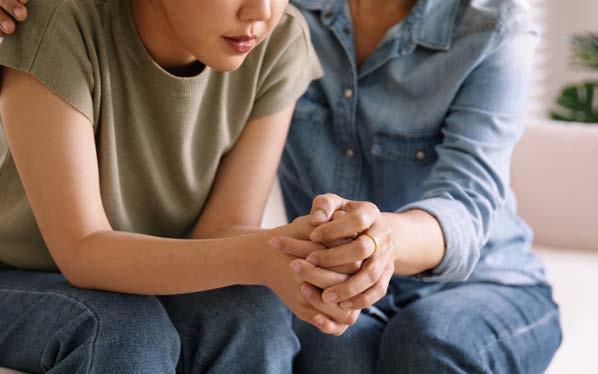

THE GLOBAL YOUTH RESILIENCE INDEX by 2024

Table of contents

Why This Report Matters
Navigating adolescence requires resilience, a quality that enables positive psychological and social outcomes.
The Global Youth Resilience Index’s findings are crucial for understanding how high school students from various cultures cope with challenges and stress, aiming to enhance educational strategies and support systems for fostering resilience in youth. This analysis could guide educators, policymakers, and parents in creating more supportive and effective learning environments.
Educatius' study across nine countries reveals how vital social support is for fostering resilience among teenagers. Intriguingly, resilience varies across cultures and genders, highlighting the diversity of adolescent experiences. Activities such as reduced social media use and engaging in cultural and language immersion have an impact on resilience.
Educatius is committed to supporting these resilience factors through its programs, understanding the critical role of nurturing the well-being of international students while they are far from home. This analysis underscores Educatius' commitment to empowering global youth.

About the Global Youth Resilience Initiative
by EducatiusFocused on the well-being of its students, Educatius has undertaken a groundbreaking initiative to support the resilience of international teenagers studying on its exchange programs worldwide, with the collaboration of experienced staff, partners and teen mental health professionals.
As a global education organization that welcomes thousands of teens from over 60 countries each year onto international high school exchange programs, Educatius is responsible for the well-being of students within its care; from before the program starts, to when the student returns home or continues to university.
For the past 21 years, we have had the privilege of meeting teens from all around the world. We have flourished by seeing them flourish.
Today we know quite a bit about what it is like being a high school student on an international exchange program. And it is not always easy.
The World Economic Forum’s Publication, The Global Framework for Youth Mental Health presents a new paradigm for Youth Mental Health:
• Accessibility
• Community based
• Non-judgemental
• Non-stigmatizing
• A place of trust that makes young people feel comfortable

Studies show an alarming rise of mental health issues among high school students. In our daily work, we see a clear indication of that. More students than ever are reaching out to us due to mental health problems such as anxiety and depression.
“For centuries, the high rate of childhood mortality was the single biggest threat to society. Today, youth mental health issues have replaced this.”
• Health organizations worldwide are reporting an increase in teen mental health challenges.
• Globally, one in seven 10–19 years olds experience a mental disorder, accounting for 13% of the global burden of disease in this age group.
• Depression, anxiety, and behavioral disorder are among the leading causes of illness and disability among a dolescents.
• 75% of all mental disorders develop by the age of 25.
Source: World Economic Forum, 2023
Over 21 years, we have witnessed that students who successfully complete a high school program abroad report and demonstrate remarkable growth resilience factors – like confidence, a sense of purpose, discipline, independence, wider perspectives, adaptability, improved interpersonal relationships and self-esteem.
“The experience changed me internally, it made me grow. I learned to overcome the bad times, I learned how to enjoy the little things, and above all I learned that in life there is always something to learn, and there are so many people to love.”
Diletta, Italy
“I learned that I have more discipline and confidence in myself. I can open my heart and make friends with more people.”
Quan, Vietnam
“I am capable of more than the eye can see and I will believe more in myself. I now can do a lot of things alone, that I was afraid of before. I grew a lot in these months away from home."
Leah, Germany
“I learnt that I'm actually quite a social person. I also found out more about who I am, who I want to be and how I can achieve that. It's not that I changed my principles, it's more that my character got stronger.”
Stella, Switzerland
“My exchange year helped me develop sense of responsibility in real life. It showed me how to manage obstacles and be able to be independent. It also let me meet people that had a big impact on me and changed my perspective.”
Amelia, Poland


But the trend of increasing youth mental health challenges means they may need extra support to adapt to their new environment.
Youth on an exchange program experience the same mental challenges as students who do not travel abroad. However international students must also navigate unique challenges such as culture shock, homesickness, and a new academic environment.
To guide the practical execution of our initiative, Educatius’ experienced staff collaborated with Stella Barnhälsa, an organization dedicated to enhancing the well-being of children and adolescents struggling with mental health challenges.
Stella Barnhälsa’s expertise stems from operating an outpatient care facility for teen mental health issues, neuropsychiatric difficulties, or challenges in their daily lives. They also elevate public awareness about youth mental health by collaborating on joint initiatives with organizations that interact with teens, including healthcare providers, educational institutions, and community organizations.
Stella Barnhälsa was founded by pediatrician Christine Werner and psychologist Isabelle Palmborg, with a shared vision to aid children, adolescents, and families.
They achieve this by offering interventions grounded in versatile expertise, a creative and flexible approach, and the understanding that both preventive and therapeutic efforts are necessary to enhance the mental health of children and youth.
Medical doctor Christine Werner is a specialist in pediatrics and adolescent medicine. With her extensive knowledge and experience working with children and youth in both educational and healthcare settings, she emphasizes the importance of early interventions to prevent mental health challenges.
Psychologist Isabelle Palmborg developed an interest in supporting the mental well-being of children and adolescents at an early stage. Her experiences in child and adolescent psychiatry have provided insights into the significant positive transformations that can occur in individuals and families when they receive the right interventions and support.
Important to note that Educatius is not diagnosing or treating students, nor is it accepting students with serious mental conditions onto its programs. Rather it is providing tools and awareness to best support and develop the resilience of students as they encounter common challenges on their high school program abroad.

THE QUICK READ
 By Educatius
By Educatius
Five takeaways from the Global Youth Resilience Index

Resilience and International Exposure
A significant finding is that teenagers with international exposure, such as travel without parents or engagement in activities abroad, tend to exhibit higher resilience. This underscores the value of student exchange programs in fostering psychological and social well-being among youth.

Social Media Usage and Resilience
The study reveals a nuanced relationship between social media usage and resilience among teenagers. While excessive use, especially at night, is associated with lower resilience factors, moderate use is linked to higher emotional insight.
Multicultural and Language Comfort
A notable aspect of the report is the emphasis on the comfort and experience of teenagers in new cultures and languages. Approximately 44.2% of participants felt comfortable expressing themselves in a non-native language, and a significant portion had traveled or lived abroad independently. This indicates the critical role of cultural immersion and language acquisition in building resilience and preparing students for global citizenship.

Gender and Cultural Differences in Resilience
The research identifies gender and cultural variations in resilience levels, with participants identifying as male generally reporting higher resilience-related factors.

Future Aspirations and Resilience
The desire to live or study abroad is strong among the surveyed teenagers, with 49% expressing this ambition for the next 3-5 years. This aspiration is linked to higher resilience, suggesting that international education not only attracts resilient students but also contributes to their personal growth.

THE RESEARCH OVERVIEW
 By Educatius
By Educatius
The Global Youth Resilience Index by
Educatius, surveyed over 4,000 teenagers aged 16-20 from 9 countries
This survey examined that resilience, the capacity to overcome stress, is associated with a range of positive psychological and social outcomes. More resilient teenagers tended to feel better connected to their family, friends, school, and community. They also tended to perceive their family and friends as more available and their schools as more supportive.
These teenagers were somewhat more comfortable with expressing themselves in a foreign language and spent a bit less time on social media. They also tended to engage in more mental resilience activities such as sports, exercise or eating healthful foods. There were pronounced differences between countries in the results.
The survey which was based on the MCRI’s Adolescent Resilience Questionnaire (ARQ), was conducted by the YouGov analysis institute using CAWI methodology.
Total respondents: 4 079
Ages on panel: 16 – 20 year olds
Gender: 60% female 40% male
Fieldwork: September 2023
What is resilience?
Resilience is the ability to bounce back from adversity, challenges, or setbacks. It involves adapting positively to difficult circumstances, learning from experiences, and maintaining mental and emotional well-being. Resilient individuals can navigate life's ups and downs with a sense of purpose, optimism, and perseverance. Building resilience often involves developing coping mechanisms, fostering social support, and cultivating a mindset that embraces change and growth.
How can we measure resilience in youth?
Resilience is a psychological characteristic, something we cannot observe directly, and further something that people cannot directly report. Instead, we make inferences about it indirectly by asking questions that we hope will produce answers indicative of resilience.
This survey examined five distinct psychological characteristics that determine one’s resilience:
• Empathy or tolerance for people (being patient or tolerant with people)
• Social skills (being able to express oneself in a group, or make major decisions)
• Emotional insight (the ability to regulate own emotions)
• Confidence (self-confidence)
• Negative cognition (thoughts of worry or unworthiness)
Further, this resilience is measured across five domains. The family, school and peer domains consist of feelings of connectedness with individuals from each of these domains, as well as the perceptions by youth of availability of these individuals. The community domain consisted solely of a connectedness scale, while the school domain has perception of the school as a supportive environment instead of availability.

64 %
“I look for what I can learn out of bad things that happen”
A note about measurement invariance
To accurately compare resilience factors among teenagers from various countries and cultures in the Global Youth Resilience Index, it's crucial to ensure that differences in responses truly reflect variations in psychological characteristics rather than differences in answering styles or cultural interpretations of survey questions.
The Index found that while most resilience-related factors showed enough measurement invariance to indicate psychological traits across countries, it wasn't sufficient to determine if a trait was more pronounced in participants from specific countries.

However, comparisons of these factors' relationships with habits and characteristics revealed significant differences between countries.
It's also noted that in the Index, higher scores generally indicate better outcomes. For instance, higher empathy/tolerance scores suggest greater empathy/tolerance, and higher connectedness scores imply stronger connections. Conversely, higher scores in negative cognition mean fewer negative cognitive processes, for instance, worrying less.

THE RESULTS
 By Educatius
By Educatius
Resilient individuals tend to feel better connected with friends, family, and school
Participants with more beneficial values (i.e. higher) on resilience characteristics tended to feel better connected with their families and to perceive their family members as more available for them when needed. These associations were particularly strong with participants’ confidence and emotional insight.
Participants with stronger emotional insight and confidence reported feeling better connected with their friends. Connectedness with friends was more pronounced in participants with better social skills, although this association was weak. Participants with good social skills and less negative cognition felt that their friends are more available to them. Friends/ peer availability was positively associated with the
other individual resilience factors, but the associations were weaker.
School connectedness was strongest in participants with good social skills and little negative cognition. On the other hand, participants with good emotional insight and high confidence tended to perceive the school environment as the most supportive. These individuals also tended to report higher feelings of connectedness with their community.

Resilient individuals spend slightly less time on social media
Time spent on social media was weakly associated with individual resilience factors. Participants who reported spending less time on social media tended to be slightly more empathetic/tolerant, to experience fewer negative cognitions and to have marginally better social skills on average. However, these differences are all small, and detectable only because of the very large number of survey participants.
Participants who reported using social media in bed at night tended to score slightly higher on emotional insight and connectedness with friends, but somewhat worse on average on empathy, negative cognition, social skills, connectedness with school and with community.
really care how they present themselves on social media
45 % enjoy going to school
52 % hate going to school

49 % have trouble explaining how they are feeling
30 %

Social media use
Most participants spend up to 20 hours per week on social media
62.5% of participants spend up to 20 hours on social media in a typical week. 27% reported spending more than 20 hours in a typical week. Participants differed greatly in their reported number of hours, but the most frequently reported intervals were 6-10 hours per week and 1-5 hours per week. 173 participants reported spending more than 50 hours per week on social media.
Comparison of countries showed that, on average, Swedish and Vietnamese participants reported the longest time per week spent on social media, while those from France and Brazil reported the shortest.
In a typical week, approximately, how much time would you spend using any social media (read, post, interact, etc) on any devices?
Don't
Not applicable - I don't use social media
Swedish and Vietnamese teens spend the most time on social media

In a typical week, approximately, how much time would you spend using any social media (read, post, interact, etc) on any devices?
(eta=.149, p<0.001)

On average, females reported spending 2.1 hours more per week on social media than males
In a typical week, approximately, how much time would you spend using any social media (read, post, interact, etc) on any devices? Average number of hours (eta=.072, p<0.001)
Most participants use social media in bed at night on a regular basis
Most survey participants use social media in bed at night on a regular basis. This is most often the case in Sweden, Vietnam, Spain, Italy, and Brazil where around 3 out of every 4 teenagers report doing this. Using social media in bed at night on a regular basis is the least common in Germany and China where only 53% and 60% of teenagers reported this practice.
In all surveyed countries the share of girls using social media in bed at night is substantially larger than the share of boys. The difference between shares of boys and girls doing this is the smallest in Sweden and the USA, but even in these two countries the share of girls using social media at night is still greater than the share of boys.
Do you use social media in bed at night on a regular basis?

German and Chinese teens spend the least time on social media at night

Do you use social media in bed at night on a regular basis?
Experience and comfort in new culture and languages
The Global Youth Resilience Index also sought to understand teens’ level of experience and comfort in an international context, and how those factors were related to resilience factors.

44 %
are comfortable using another language than their native one
42 %
have traveled abroad without close family members
Shares of participants comfortable with speaking in a foreign language differ across countries
There are pronounced differences between countries in shares of participants comfortable in expressing themselves in a language different from their own native language. While more than half of participants from Sweden, Vietnam and Brazil reported being comfortable expressing themselves in a language different from their native language, this was the case with only 35% of USA participants and 28% of participating Brazilians.

Do you feel comfortable expressing yourself in a different language than your native language?
(Cramers' V=.178, p<.001)
Teenagers from different countries differ in how often they traveled without parents or family
The shares of participants who travelled abroad without their parents or family members are the highest in the European Union countries included in the survey, while being the lowest in Brazil and China. The high share of participants with experience of travelling abroad without family in the European Union countries (Spain, Germany, France, Sweden, and Italy) compared to China, Brazil or USA could at least partly be explained by the fact that the European Union countries are much smaller, hence one does not need to travel very far to find him/herself abroad.
Additionally, these countries are closely integrated and travel between them is often as easy as travelling to a nearby town, while still qualifying as travel abroad. This is profoundly unlike the situation in larger countries such
as the USA, Brazil, or China, where travelling abroad typically means covering much more distance and requiring much more preparation.
Percentages of participants who have been away from home without parents for more than 2 weeks is above 50% in all countries except Brazil. Still, it is particularly high in Vietnam where 2 out of every 3 participants report having such an experience.
Italian, Vietnamese, and Spanish participants most often reported wanting to live or study abroad on their own.
Have you ever traveled abroad without your parents or close family members?
(Cramer's V=.409, p<.001)
More than 50% of participants from Italy, Vietnam, Spain, and the USA reported that they would want to live or study abroad on their own within the next 3-5 years. Shares of such respondents were lower in other countries, but not much lower. The exception is Germany, where only 29% of survey participants reported such a desire.

Have you been away from home without your parents for more than 2 weeks? For instance at a language school, sports camp, or something similar (Cramers' V=.145, p<.001)
% of participants from a country who answered Yes

55 %
have been away from home more than 2 weeks without their parents want to study abroad within the next 3–5 years
49 %
Do you want to live or study abroad on your own within the next 3-5 years?
(Cramers' V=.175, p<.001) Italy
Resilient participants had more travel experiences without parents and family members
On average, participants who reported feeling comfortable expressing themselves in a foreign language had more beneficial values on all individual and social resilience-related factors save empathy, compared to those who did not report this. The differences were small, but statistically significant and the most pronounced difference was on “confidence.” They were more confident than those who do not feel comfortable expressing themselves in a foreign language.
Participants who have travelled abroad without their family members had somewhat higher confidence, connectedness with friends and family and perceived their friends and family as more available compared to those without such travel experiences. They also had a bit better social skills on average. The strongest difference was in the feeling of connectedness with friends.
Participants who were away from home without their parents for at least two weeks, on average had higher emotional insight, confidence, and social skills. They also tended to perceive their family members as more available to them, and to feel better connected with their friends, school, and community.
Participants who reported wanting to live or study abroad tended to have higher confidence, emotional insight, and less negative cognition. They also tended to feel better connected with their friends and school, while perceiving the school environment as more supportive.
Students who completed a high school program abroad in 2023 shared how the experience impacted them, illustrating the intersection between international experience and resilience
"Immersing myself in a different culture allowed me to gain a deeper understanding of myself. I learned that I am adaptable and capable of embracing new challenges and unfamiliar situations. I discovered strengths I didn't know I had!"
Cali, France
“I learned I'm better and more capable of everything than I thought.”
Jose, Spain
“I have learned that I can easily adapt to a different environment. Living in a such a diverse American society opened my heart. Reaching out when there are questions, making more friends, taking part in extra-curricular activities also encouraged me to step out of my comfort zone."
Henrick, Vietnam
“When I left, I was nervous and didn't know what to expect; now I'm in the same position - but I'm confident. Life is always changing, that's unavoidable, but you can smile thinking about the good memories and be excited for what's about to happen."
Maria, Italy

"I learnt how to organize things on my own and how to be more independent in general. I would say that after my year I know what I like, what I don't, and can decide things more easily.”
Franziska, Germany
“I feel more independent and able to take more responsibility. Before I was very shy, but this year has brought me out of my shell, and I feel more comfortable in myself.”
Emma, Sweden
“Now I know that I can do anything. I achieved goals that I had, and others that I didn't even know I had. I tried and experienced 100 more new things that I never thought I would!”
“I learned a lot of things about myself and if we fail, no problem; we need to keep going. I also improved my personality and how to have a relationship with other people.”
Niccolo, Switzerland

“I learnt to rely on myself and open my mind to new experiences. I will always remember that new experiences are best when shared - no can help you if you try to go it alone.”
Owen, USA
Maria Clara, Brazil
Gender differences in resilience across countries
Male participants tend to score somewhat higher on resilience-related factors
Looking at gender differences across countries, boys tend to report somewhat higher levels on most resilience-related factors across all countries. There are very few cases where girls reported higher resilience levels. However, the specific resilience-related factors vary from country to country.
The highest differences between boys and girls across all countries were found in negative cognition, where boys tend to report much less negative cognition on average and on social skills, where boys tend to report better social skills.
Girls from Germany tend to report feeling better connected with their friends compared to boys on average. Girls from France, on average, perceive their friends as more available compared to French boys.
These differences are presented in the following graphs. In each graph, average values of femalesgirls are set to 1, and the values of males - boys are presented as the difference from that value in standard deviations. Countries where gender differences found in this survey are large enough to be generalizable to the population (i.e., where differences are statistically significant) have black borders and the scores of males are given above the bar. For ease of representation the given score is 1 + the difference from females in units of the standard deviation of the whole sample. For example, a score of 1.29 means that the average of males is 0.29 standard deviations higher than the score of females. A score of males of 0.8 would mean that the average of males is .2 standard deviations below the average of females (because 1-0.2 = 0.8).
Empathy
Boys from Spain, Italy and Brazil had higher scores on empathy compared to girls from these countries.
Emotional insight
Differences between boys and girls in average levels of emotional insight were observed only in French participants, where boys reported on average somewhat higher emotional insight. Female = 1 Male
Confidence
Gender differences in confidence were found in France and China, where boys tended to have higher values in confidence. Boys had somewhat higher average confidence levels in all countries, but only in France and China were they large enough to be significant.

The largest gender gap was observed in negative cognition

Negative cognition
Boys have higher scores on negative cognition, indicating that they are less prone to negative cognition than girls. These are the largest observed gender differences. They were the most pronounced in Sweden and Italy, but were also substantial in Germany, Brazil, and the USA. In all these countries, boys tended to be less prone to negative cognition than girls (since coding that was done in such a way that beneficial values have higher numbers, higher scores on negative cognition mean that a person is less prone to negative cognition).
Social skills
“Social skills” is the second resilience-related characteristic where pronounced gender differences were observed. It is the same 5 countries where the differences are present – Sweden, USA, Germany, Italy, and Brazil. This time, the differences were the most pronounced in Italy, but they are also substantial in the other 4 countries. In all these 5 countries, boys tend to have higher scores.
In France and China, girls have higher average scores on social skills compared to boys in the survey sample, but the difference is minor.
Family connectedness
Boys in the USA, France, Brazil, and Vietnam tend to report feeling more connected on average to their families compared to girls. Girls in Sweden and Spain on average reported feeling a bit better connectedness with family compared to boys, but these differences are small.
Family availability
Boys in the USA and Vietnam also tend to perceive their family members as more available to them compared to girls.
Friends connectedness
The only substantial difference between boys and girls in the average level of their connectedness with friends is found in Germany. German boys feel substantially less connected to their friends compared to girls.

Friends availability
Looking at the perceived availability of friends, French boys see their friends as much less available compared to girls. On the other hand, boys from Italy and Brazil see their friends as more available compared to girls.

School connectedness
Vietnamese boys tend to feel somewhat less connected to their schools compared to girls. The situation is similar in France and Spain, only slightly more girls than boys reported. Female
School supportive environment
Boys in France, Germany and Brazil see the school environment as more supportive than girls do. Actually, average scores on this perception are higher in boys than in girls in all countries, but it is only in France, Germany, and Italy that it is large enough that it can be concluded that it is not due to chance.
Community connectedness
Boys from Brazil, France, and Vietnam report feeling better connected with their communities compared to girls. Female =

The number of resilience factors boys and girls differ on across countries
Looking at the number of observed gender differences in resilience-related factors, they were the most often present in Brazil and France (gender differences on 7 and 6 factors, respectively). Participants of different genders from Spain and China differed only on 1 resilience-related variable each, indicating that gender differences in resilience in these two countries are the least pronounced.
The number of countries where boys and girls differ on each resilience factor
Looking at specific resilience-related factors, results show that in 5 out of 9 countries there were significant differences in social skills and negative cognition between boys and girls. Boys and girls differed in family connectedness in 4 countries. This can be taken to mean that gender differences are the most pronounced in negative cognition and social skills. In contrast, gender differences in connectedness with school, with friends, and in emotional insight were present only in 1 country each. These were the factors with the least gender differences.
Gender differences are the most pronounced in negative cognition and social skills

Resiliencesupporting activities
We asked what kind of activities teens participate in and examined the correlation with resilience factors.
The most common mental resilience practices are sleeping and exercising
Mental resilience activities - Which of the following kinds of activities, if any, would you say that you do on a regular basis?
Sleep 8 hours a night
Exercise
Eat healthful food
Play sports
Spend time in nature
Practice an art/play an instrument
Help others/community service
Mindfulness/meditation
The most frequent mental resilience activities are sleeping 8 hours a night, exercise, and eating healthful food. Still, fewer than 50% of survey participants report doing each of these. Mindfulness or meditation and helping others/community service are the least often reported mental resilience activities.
58 %
If something upsets me, it affects how I feel about everything

Gender and Country Breakdowns of Resilience Activities
Playing sports and exercise are much more common in boys
Mental resilience activities - Which of the following kinds of activities, if any, would you say that you do on a regular basis?
Comparing girls and boys, results show that playing sports and exercising are more frequent among boys. In contrast, eating healthful foods, sleeping 8 hours a night, and practicing an instrument are more frequent among girls, but the difference is very small –only slightly more girls than boys reported practicing these activities. In contrast, the differences in percentages between genders on exercising and playing sports are both over 10%.
Sleeping and exercising are the most popular mental resilience activities in all countries except Germany and China
Mental resilience activities - Sweden
Mental resilience activities - USA
Mental resilience activities - Germany
Mental resilience activities - France
Mental resilience activities - Spain

Mental resilience activities - Italy
Mental resilience activities - Brazil
Mental resilience activities - China
Mental resilience activities - Vietnam
Comparing mental resilience activities across countries, results show that sleeping 8 hours a night and exercising are the two most frequently reported activities in all countries except Germany and China. In Germany and China, the two most popular mental resilience activities are eating healthful and sleeping 8 hours a night (Germany) or eating healthful and exercising (China).
Looking at the first three most popular activities, Germany differs from the other countries in that spending time in nature is the third most popular activity there, while this factor does not reach this ranking in any other country.
Chinese teens had the most engagement in resilience activities overall.

The average number of different mental resilience activities reported
Participants from China, on average reported doing more different mental resilience activities (eating healthful, exercising, sleeping etc.) compared to the other countries. An average Chinese survey participant reported doing between 3 and 4 different mental resilience activities, while this number was 2 or between 2 and 3 in all the other countries.
The lowest average number of different mental resilience activities reported was in Italy and Brazil.

Mental
resilience activities
were associated with all resilience-related factors
Participants who reported exercising, playing sports, and helping others/doing community service tended to have, on average, slightly higher scores on all resilience-related factors except empathy.
Participants who reported playing an instrument tended to report slightly higher connectedness with friends, family, and school compared to those who did not report playing an instrument.
Participants who reported spending time in nature and those who reported eating slightly healthful food tended to have slightly higher scores on all resilience-related factors.

Sleeping 8 hours a night was positively associated with all resilience-related factors, except empathy and connectedness with the community.
Participants who reported practicing mindfulness or meditation tended to score somewhat higher on emotional insight, confidence, negative cognition, and social skills. They also tended to score slightly higher on connectedness with school and to perceive the school environment as more supportive compared to the those who did not report doing this activity.
Regional comparisons of resilience scores

The only difference in resilience scores between regions of Germany was on the perception of school as a supportive environment.
• It was the highest in Berlin, Brandenburg, Mecklenburg-Vorpommern and SachsenAnhalt regions.
• It was the lowest in Sachsen, Thüringen, Bremen, Hamburg, Niedersachsen, and Schleswig-Holstein regions.
In Italy, regional differences were present on emotional insight and family availability.
• Participants from the islands had the highest emotional insight score on average, while those from the Northwest and the Northeast regions had the lowest.
• Family availability tended to be the best in the South and the Islands, and the lowest in the Northwest and Northeast regions.
Some countries’ scores vary depending on the region
In China, participants from different regions differed in empathy, negative cognition, social skills, availability of friends, and connectedness with school.
• Participants from the Eastern region had the lowest empathy scores, while scores of those from the Southern, Central and West regions were all above average.
• Negative cognition was the most common in Eastern and West region, while those from Southern, Central and North & North-Eastern region were the least prone to it.
• Participants from the eastern region scored worse on social skills compared to the other regions.
• Availability of friends and connectedness with school was lower in the Eastern region, compared to the other regions of China.
In Sweden, regional differences were present in emotional insight, family availability and perception of school as a supportive environment.
• Participants from the North central Sweden had the highest average scores on emotional insight, while those from Stockholm and the South-central Sweden had the lowest.
• Family availability was the highest in North-central Sweden, and the lowest in North Sweden and South-central Sweden.
• Participants from North-central Sweden were the most prone to see school as a supportive environment, while participants from North Sweden and Stockholm saw it, on average, as supportive the least often.
There were no statistically significant differences across regions of France and the USA in their average resilience scores.
In Spain, there were regional differences in confidence, social skills, and perception of school as a supportive environment.
• Participants from the North, South and Center of Spain tended to be the most confident, while confidence was the lowest in participants from the East and Northwest regions of Spain.
• Participants from the North and the Center regions of Spain had the highest scores on social skills, while those from the Northeast and the Northwest had the lowest.
• Participants from the Northwest region of Spain perceived school as being a much less supportive environment compared to participants from the other regions of Spain.
In Vietnam, regional differences were present in empathy, confidence, negative cognition, connectedness with friends and community and the availability of friends.
• Empathy was the highest in participants from the North and South-central coast and the lowest from Northern Midlands and the Mountains.
• Participants from the Northern Midlands and Mountains were the most confident on average, while those from the Red River Delta and North and Central Coast were the least.
• Negative cognition was the most pronounced among participants from Northern Midlands and Mountains and the least pronounced in participants from Red River Delta.
• Connectedness with friends was the most pronounced in participants from Northern Midlands and Mountains, and the least pronounced in North and South-Central Coast.
• Participants from Central Highlands and North and South-Central Coast tended to perceive their friends as the least available, while those from the Red River Delta and the Southeast saw their friends as most available.
Regional differences in travel and foreign languages
In China, the share of participants comfortable with expressing themselves in a foreign language was higher in the Eastern region than in the other regions.
• No participants from the West region travelled abroad without parents or close family members, while this percentage was over 20% in North & Northeastern and in the Southern region.
• Over 70% of participants from the Eastern region have been away from home without their parents for more than 2 weeks, but this was the case with only 49% of participants from the Central region of China.
• There were no regional differences in the shares of participants wanting to study abroad.
In Spain, 85% of participants from the North region have travelled abroad without their parents or close family members, but this was the case with only 61% of participants from the South.
In the USA, 42% of participants from the South report feeling comfortable expressing themselves in a foreign language, while this is the case with only 26% of participants from the Midwest. 44% of participants from the Northeast report travelling abroad without parents or close family, but this is the case with only 28% of participants from the South region of the U.S.
There were no regional differences on these variables in France, Germany, Italy, Sweden, and Vietnam.


Regional differences in social media use
In China, the longest average time per week spent using social media is among the participants from the Eastern region (24 hours), while participants from the Central region report spending the least amount of time per week on social media (15 hours).
Participants from the Eastern and Central Regions care the most about how they present themselves on social media, while participants from the West care the least.
While more than 75% of participants from the Eastern and Western regions of China report using social media in bed at night regularly, that is the case with only 52% of participants from the Southern and Central regions.
In France, participants in the Paris area report spending the most time on social media (17 hours/ week), while those from the South-West report spending the least (9 hours/week).
In Vietnam, participants from the Northern Midland and Mountains reported caring the most about how they present themselves on social media. This was the least the case with participants from the Southeast region and the Mekong River Delta.
There were no regional differences in social media use in Germany, Italy, Spain, Sweden, and the USA.

THE CONCLUSION
 By Educatius
By Educatius

Conclusion
The Global Youth Resilience Index has provided a comprehensive examination of factors that contribute to the resilience of youth in an international context. Through the lens of this extensive study, we have gained invaluable insights into the psychological and social dynamics that underpin the experiences of young people across diverse cultural landscapes.
The report's findings underscore the significance of international exposure and cultural engagement in enhancing the resilience of youth. With a substantial proportion of participants expressing comfort in non-native languages and a desire to study or live abroad, the data speaks to the transformative impact of cross-cultural experiences on adolescent development. These experiences not only foster resilience but also prepare students for the demands of a globalized society.
Moreover, the nuanced relationship between social media usage and resilience factors identified in the study offers a critical perspective for educators and policymakers. It calls for a balanced approach to digital engagement, one that recognizes the potential benefits of social media as a tool for emotional insight and connection, while also acknowledging the risks associated with excessive use.
The gender and cultural differences in resilience levels revealed by the research provide a foundation for tailored support within international education programs. By addressing these variations, we can ensure that student exchange initiatives are inclusive and responsive to the needs of all participants.
As we reflect on the aspirations of nearly half of the surveyed teenagers to live or study abroad, it is evident that international education is not merely an academic pursuit but a catalyst for personal growth and resilience. The commitment to nurturing global youth through educational opportunities is both timely and essential in shaping a future where resilience is recognized as a cornerstone of international education and global citizenship.
In conclusion, the report offers a roadmap for the evolution of student exchange and international education. It calls on us to embrace the diversity of adolescent experiences, to cultivate resilience through meaningful cultural exchanges, and to prepare our youth for a world that is increasingly interconnected and complex. Moving forward, let these insights serve to shape educational strategies that empower young people to navigate life's challenges with confidence and adaptability.

References
ARQ: Gartland D, Bond L, Olsson CA, Buzwell S, Sawyer SM. Development of a multi-dimensional measure of resilience in adolescents: the Adolescent Resilience Questionnaire. BMC Med Res Methodol. 2011;11(134):1-10.
The Global Youth Resilience Index by Educatius is based on the Adolescence Resilience Questionnaire (ARQ), developed to examine internal and social resilience-enhancing factors in youth. The ARQ was developed by researchers at the Murdoch Children’s Research Institute (MCRI) in Melbourne, Australia.
Hedrih, V. (2020). Adapting Psychological Tests and Measurement Instruments for Cross-Cultural. Research: An Introduction (1st Edition). Routledge, Taylor&Francis Group.
3 Pillars of Educatius’ Global Youth Resilience Initiative

Get involved: resilience@educatius.org
Scan to learn more on Educatius.org

1
A series of interactive resilience trainings for our international students; complemented by training for their host families, their natural parents, and our global staff – all crafted by teen mental health professionals and with the students’ well-being in mind.

2
A thorough review of Educatius’ operational and acceptance policies across all our global organizations to ensure transparency and student centric policies, again in partnership with teen mental health professionals and our global staff.
3
A survey of youth resilience in nine countries that shares and tracks teen resilience factors: The Global Youth Resilience Index.
